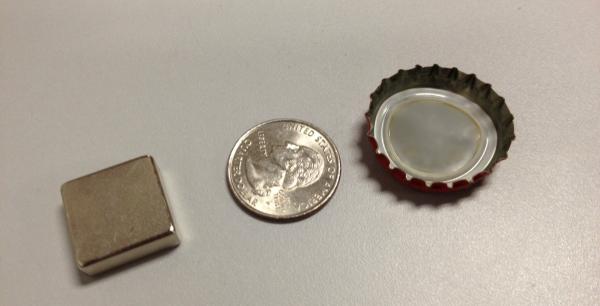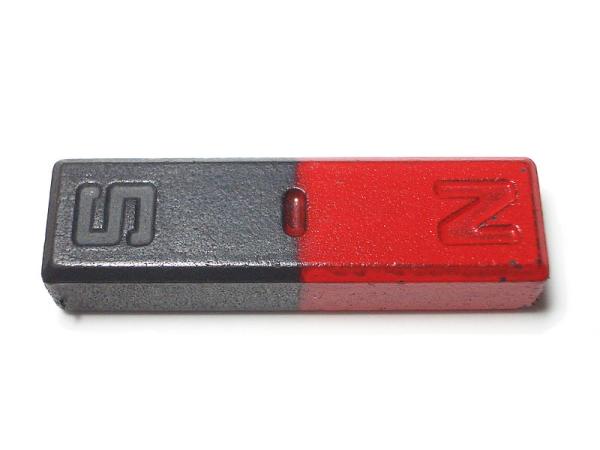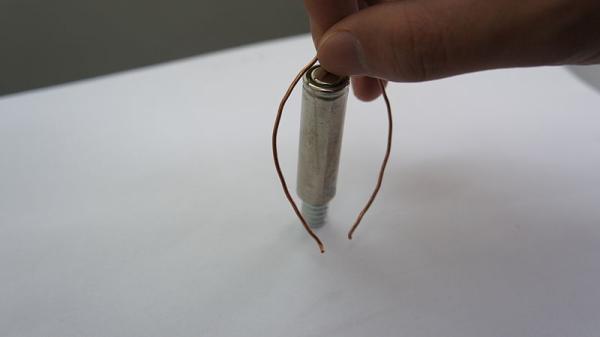Magnet Experiments
-
Magnet Experiments: Magnetic Levitation of a Superconductor
In a previous blog we discussed and conducted an experiment showing diamagnetic levitation, the phenomenon that happens when diamagnetic materials levitate in between an arranged magnetic field. In this blog, we’re discussing superconducting levitation with magnets. Superconducting levitation, also known as the Meissner effect, can be considered a “super” form of diamagnetic levitation. A superconducting material like Yttrium-barium-copper-oxide enters a state of zero electrical resistance when it reaches its superconducting point. This state seems to defy gravity by repelling magnetic fields and levitating. In this example, the temperature needed to become a superconductor with perfect diamagnetism is around 93 Kelvin or -180° Celsius. Continue reading → -
Magnet Experiments: Opening a Bottle with a Quarter and a Magnet
You may have seen a video that shows a bottle cap being popped off using only a fridge magnet and a quarter. The video has been circling the Internet recently and may seem real, but we were pretty skeptical. As magnet-enthusiasts, we naturally had to test out the legitimacy of this bottle opening trick. Continue reading → -
Magnet Experiments: What Happens to a Magnet in Cold Temperatures
High powered magnets can lift cars, and steel beams as well as crush bones or break glass. In other words, magnets are capable of some incredible feats. However, there are a few things that can alter magnet strength. One of those is temperature. In our last blog we explored what happens to a magnet when it is exposed to extreme heat. Now, let’s do an experiment to explore what happens to a magnet when it is exposed to extreme cold. Continue reading → -
Magnet Experiments: What Happens When a Magnet is Heated
Magnets can be found in many everyday items and technologies such as cars, phones and computers. It is because of permanent magnets' ability to create their own magnetic field that they are useful in various products and situations. However, they are not impervious. Magnet strength can be affected by certain environmental changes like temperature. The effect of temperature on neodymium magnets is one of the most interesting phenomenons to observe and evaluate. In this magnet experiment, we specifically explore how magnets react when exposed to extreme heat. Continue reading → -
What Will Happen to a Magnet in Water
Will a neodymium magnet lose its power when dropped in water? The simple answer is no. In fact, magnets are sometimes used for underwater recovery. Boaters and fisherman may use a magnet retrieval tool to recover some lost items such as keys or magnetic fishing gear that have been dropped in the water. However, one concern is that the magnets will begin to corrode, especially if they are made of materials like neodymium. On the other hand, water has shown diamagnetic properties. Continue reading → -
Make a Homopolar Motor with Neodymium Magnets
The homopolar motor, the simplest electric motor, was first demonstrated by Michael Faraday in the early 1800s. His demonstration showed how electromagnetism can support motion, but the design used mercury and was not advanced enough to be used for any practical application. Nevertheless, his finding made the many advanced motor-based technologies that we see today possible. Today, magnets are used in electric motors to assist in transferring electrical energy to mechanical energy. Continue reading → -
Magnet Experiments: Make Magnetic Silly Putty
You may remember playing with the stretchy and colorful goo-like globs called silly putty when you were a kid. Putty was actually invented by accident during World War II by James Wright, an engineer trying to come up with a cost-effective alternative to rubber for the U.S. military. He accidentally poured boric acid into silicone oil, creating the main ingredients of the elastic toy we know today. However, the putty we know today wasn’t marketed as a fun pastime until Peter Hodgson saw its potential as a toy and bought the production rights after it was rendered useless as the military’s rubber alternative. One substance that is even more fun to experiment with than putty is magnetic putty. Magnetic putty has the same squishy texture as silly putty but reacts with magnets in eye-catching ways. You can make your own magnetic putty with this simple and quick tutorial. Because this experiment uses iron oxide powder it is meant for adult use only and should not be done with small children. Continue reading → -
Experiment: Remove Iron from Cereal
You may have heard tales of the additives in processed foods, but have you ever actually seen them? Unlike fairy tales, food additives do exist and can be found in many common processed foods. Continue reading → -
Diamagnetic Levitation Experiment with Cube Magnets
Diamagnetic materials hold properties that repel an applied magnetic field. Because of these properties, it is possible to levitate a magnet when used in conjunction with diamagnetic materials. The principle of diamagnetic levitation has been known since the 1930s but has only recently been used in practical applications like transport systems. A diamagnetic levitation experiment like the one below is both fun and educational. Continue reading → -
Magnet Science Experiments for April 1st
Since today is renowned for its trickery, we’re honoring it with some cool science experiments that are great in classroom and learning settings to show the relationship between magic and science. Continue reading →










